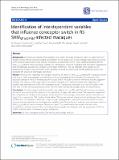| dc.contributor.author | Zhuang, Ke | |
| dc.contributor.author | Finzi, Andres | |
| dc.contributor.author | Toma, Jonathan | |
| dc.contributor.author | Frantzell, Arne | |
| dc.contributor.author | Huang, Wei | |
| dc.contributor.author | Sodroski, Joseph Gerard | |
| dc.contributor.author | Cheng-Mayer, Cecilia | |
| dc.date.accessioned | 2013-10-17T19:41:44Z | |
| dc.date.issued | 2012 | |
| dc.identifier.citation | Zhuang, Ke, Andres Finzi, Jonathan Toma, Arne Frantzell, Wei Huang, Joseph Gerard Sodroski, and Cecilia Cheng-Mayer. 2012. Identification of interdependent variables that influence coreceptor switch in R5 SHIV\(_{SF162P3N}\)-infected macaques. Retrovirology 9(1): 106. | en_US |
| dc.identifier.issn | 1742-4690 | en_US |
| dc.identifier.uri | http://nrs.harvard.edu/urn-3:HUL.InstRepos:11181039 | |
| dc.description.abstract | Background: We previously reported that adoption of an “open” envelope glycoprotein (Env) to expose the CD4 binding site for efficient receptor binding and infection of cell targets such as macrophages that express low levels of the receptor represents an early event in the process of coreceptor switch in two rapidly progressing (RP) R5 SHIV\(_{SF162P3N}\)-infected rhesus macaques, releasing or reducing Env structural constraints that have been suggested to limit the pathways available for a change in coreceptor preference. Here we extended these studies to two additional RP monkeys with coreceptor switch and three without to confirm and identify additional factors that facilitated the process of phenotypic conversion. Results: We found that regardless of coreceptor switching, R5 viruses in SHIV\(_{SF162P3N}\)-infected RP macaques evolved over time to infect macrophages more efficiently; this was accompanied by increased sCD4 sensitivity, with structural changes in the CD4 binding site, the V3 loop and/or the fusion domain of their Envs that are suggestive of better CD4 contact, CCR5 usage and/or virus fusion. However, sCD4-sensitive variants with improved CD4 binding were observed only in RPs with coreceptor switch. Furthermore, cumulative viral load was higher in RPs with than in those without phenotypic switch, with the latter maintaining a longer period of seroconversion. Conclusions: Our data suggest that the increased virus replication in the RPs with R5-to-X4 conversion increased the rate of virus evolution and reduction in the availability of target cells with optimal CD4 expression heightened the competition for binding to the receptor. In the absence of immunological restrictions, variants that adopt an “open” Env to expose the CD4 binding site for better CD4 use are selected, allowing structural changes that confer CXCR4-use to be manifested. Viral load, change in target cell population during the course of infection and host immune response therefore are interdependent variables that influence R5 virus evolution and coreceptor switch in SHIV\(_{SF162P3N}\)-infected rhesus macaques. Because an "open" Env conformation also renders the virus more susceptible to antibody neutralization, our findings help to explain the infrequent and late appearance of X4 virus in HIV-1 infection when the immune system deteriorates. | en_US |
| dc.language.iso | en_US | en_US |
| dc.publisher | BioMed Central | en_US |
| dc.relation.isversionof | doi:10.1186/1742-4690-9-106 | en_US |
| dc.relation.hasversion | http://www.ncbi.nlm.nih.gov/pmc/articles/PMC3528637/pdf/ | en_US |
| dash.license | LAA | |
| dc.subject | R5 SHIV | en_US |
| dc.subject | Coreceptor switch | en_US |
| dc.subject | CD4 binding | en_US |
| dc.subject | Macrophage infection | en_US |
| dc.title | Identification of Interdependent Variables that Influence Coreceptor Switch in R5 SHIV\(_{SF162P3N}\)-Infected Macaques | en_US |
| dc.type | Journal Article | en_US |
| dc.description.version | Version of Record | en_US |
| dc.relation.journal | Retrovirology | en_US |
| dash.depositing.author | Sodroski, Joseph Gerard | |
| dc.date.available | 2013-10-17T19:41:44Z | |
| dc.identifier.doi | 10.1186/1742-4690-9-106 | * |
| dash.contributor.affiliated | Sodroski, Joseph | |


